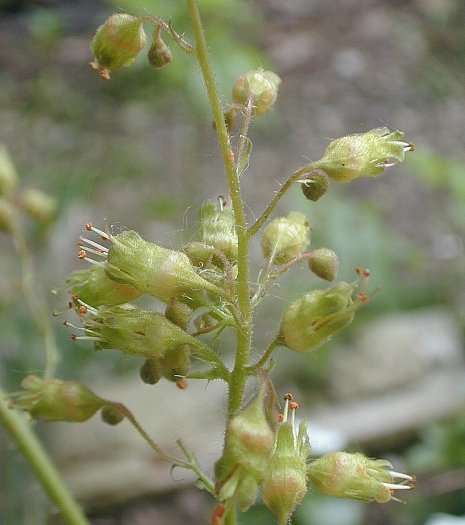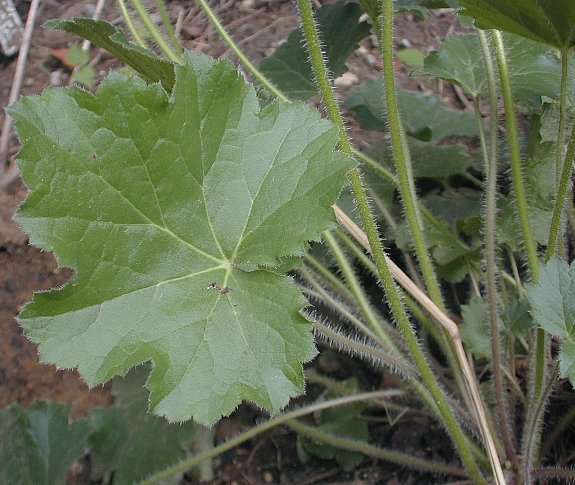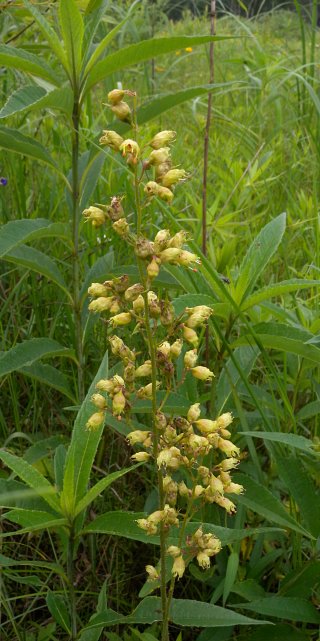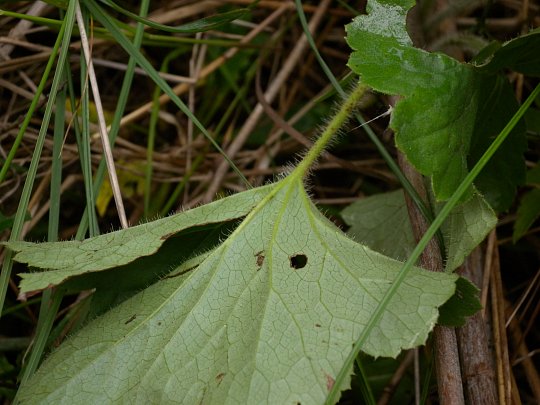Description: This herbaceous perennial plant consists of a rosette of basal leaves. The mature leaves are about 3-5" across, palmately lobed, and orbicular or slightly cordate in shape. Their margins are coarsely serrate or dentate, often with straight white hairs along the major veins on the underside of each leaf. The petioles are longer than the leaves. They have straight white hairs that are quite long and conspicuous. From the center of the rosette emerge several flowering stems that are 2-4' tall. These stems are without leaves and have straight white hairs like the petioles.

Each stem terminates in a narrow panicle of greenish flowers. Sometimes the flowers have yellowish or reddish tints when they are exposed to the sun. Each flower is about 1/8" (3 mm.) long, consisting of a cylindrical calyx that is divided into 5 lobes. There are 5 inconspicuous petals within the calyx, while 5 stamens with orange anthers are exerted beyond the calyx. The blooming period is usually early summer, and it lasts about a month. There is no floral scent. Small capsules develop, containing tiny unwinged seeds, which are dispersed by the wind. The root crown is stout and short, dividing into coarse fibrous roots.

Cultivation:
The
preference is light shade to full sun, and mesic to dry conditions.
This plant prefers rocky soil, but it will grow in clay-loam, loam, or
sandy soil. Once established, it is an easy plant to grow.
Range & Habitat:
The native Prairie Alumroot occurs occasionally in the northern
two-thirds of
Illinois,
but it is rare or absent in southern Illinois (see Distribution
Map). Habitats include upland areas of black soil prairies,
hill prairies, gravel prairies, sand prairies, limestone glades, and
rocky upland woodlands. Generally, Prairie Alumroot favors areas with
poor rocky or sandy soil where there is reduced competition from taller
plants.

Faunal
Associations:
Small bees pollinate the flowers, including Halictid bees and
cellophane
bees (Colletidae). One bee species, Colletes aestivalis,
is a specialist pollinator (oligolege) of alumroots (Heuchera spp.).
Both nectar and pollen are available as floral rewards to such
visitors. A flea beetle, Altica
heucherae, feeds on alumroots; it is oligophagous (Clark
et al., 2004). Some aphids (Nasonovia spp.) suck plant juices from
these plants; they are also oligophagous (Blackman & Eastop,
2013). White-tailed Deer browse on the foliage of Prairie Alumroot
sparingly (Voigt Englund & Meyer, 1986).
Photographic
Location:
The photographs were taken at the edge of the postage stamp prairie of
Dave Monk in Champaign, Illinois, and a sand prairie at Illinois Beach
State Park in Lake County, Illinois.

Comments: This plant has a similar appearance to Heuchera americana (Common Alumroot). Generally, Prairie Alumroot has straight white hairs on the petioles of the leaves and the flowering stems, while Common Alumroot has short appressed hairs (lying against the flowering stems or petioles), or is devoid of conspicuous hairs. The flowers of Prairie Alumroot are slightly larger in size (about 1/8" or 3 mm. long), while those of Common Alumroot are about 1/10" (2.5 mm.) long. The flowers of Prairie Alumroot are often longer at the top than the bottom, while those of Common Alumroot are more symmetrical. Across different localities, there are significant variations in the characteristics of this plant, and different varieties have been identified. In Illinois, var. grayana has flowers that are strongly asymmetric, while var. affinis (as illustrated in a photograph above) has flowers that are only slightly asymmetric. Plants with reddish leaves and silver markings have been introduced by the nursery trade, which are sometimes grown in flower gardens. The wild plant, however, isn't very showy.